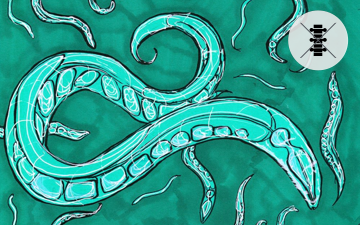Caenorhabditis elegans (/ˌseɪnoʊræbˈdaɪtəs ˈɛləɡænz/[2]) is a free-living (not parasitic), transparentnematode (roundworm), about 1 mm in length,[3] that lives in temperate soil environments. The name is a blend of the Greek caeno- (recent), rhabditis (rod-like)[4] and Latin elegans (elegant). In 1900, Maupasinitially named it Rhabditides elegans, Osche placed it in the subgenus Caenorhabditis in 1952, and in 1955, Dougherty raised it to the status of genus.[5]
C. elegans is an unsegmented pseudocoelomate, and lacks a respiratory and a circulatory system. It possesses gut granules which emit a brilliant blue fluorescence, a wave of which is seen at death in a ‘death fluorescence’.[6] The majority of these nematodes are hermaphrodites. Males have specialised tails for mating that include spicules.
In 1963, Sydney Brenner proposed research into C. elegans primarily in the area of neuronal development. In 1974, he began research into the molecular and developmental biology of C. elegans, which has since been extensively used as a model organism.[7]
C. elegans was the first multicellular organism to have its whole genome sequenced, and as of 2012, the only organism to have its connectome (neuronal “wiring diagram”) completed.[8][9]
(From: Wikipedia, June 2016)




